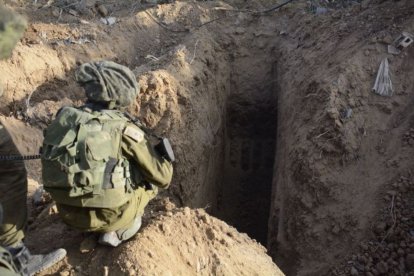Israel prepares for the ultimate challenge: Attacking Hamas' tunnels in Gaza
Terrorists have over 300 miles of passageways below the surface with command centers and arsenals that are unreachable by conventional aviation missiles.

Soldados israelíes, frente a la entrada de un túnel de Hamás en 2014./F
Israel reiterated that it will not end the war until Hamas is eradicated. This will surely require the destruction of the tunnels that the terrorist organization has under "hospitals, schools, mosques and homes" in Gaza. Given their complexity and depth, aviation attacks with conventional weapons are practically useless, and only the entry of troops on foot, supported by more soldiers and tanks on the surface, can guarantee success. However, this strategy likely involves a high number of military and civilian casualties.
The tunnels prove that Hamas is stealing from Palestinian citizens
In 2021, Hamas claimed that there were some 311 miles of tunnels beneath Gaza. At first, these tunnels were used for smuggling between Egypt and Israel. Since Hamas came to power in 2007, terrorists began to reform and reinforce them, turning them into an underground fortress. The IDF estimates that there are about 1,300 tunnels now. Through this network, built like a labyrinth, terrorists can launch attacks on Israel and disappear, as well as move and house people, goods, rockets and ammunition. In addition, they serve as a base for Hamas leadership. Israeli soldiers refer to them as the "Gaza metro."
The complexity and presumed cost of a tunnel system of this magnitude confirms accusations by Israel and other critics of Hamas that the terrorist group that governs Gaza is using the funds provided to the Gazan population for terrorist activity. For example, the tunnels have been reinforced with tons of concrete to turn them into impenetrable bunkers. These resources were sent by other countries and NGOs to help the city's civilians reinforce and build homes.
Unreachable by conventional weapons
However, this concrete has served to make these tunnels even more secure against air attacks. Some experts point out that there are two levels of depth, a first about 100 feet below the ground, which is difficult to attack with conventional missiles, and a second, where the command centers and arsenals are located, about 230-260 feet below the surface, completely unreachable, except by nuclear weapons. Furthermore, given the density of buildings on the strip, any air attack against the tunnels would lead to the destruction of a large number of civilian buildings.
Below hospitals, mosques and homes
The terrorists have also strategically placed entry and exit points on the surface. There are several hidden entrances in places such as hospitals, the United Nations headquarters on the ground, mosques and homes. Given the population density of the Gaza Strip, it is obvious that many are located in residential areas. However, in addition, another considerable number of access points have been placed in open fields where Hamas can fire rockets at Israeli cities, and they are especially difficult for Israeli troops to find.
Hostages potentially being held in the tunnels
Furthermore, Yocheved Lifshitz, the hostage released by the terrorists last week, claimed that the rest of those kidnapped by Hamas are most likely being held in the tunnels, which she described as "a spider's web" that they traversed for miles. Taking into account that Hamas is not afraid to use Palestinian citizens as human shields, it is not an unreasonable conclusion that they plan to do the same with these prisoners, further complicating the operation.
Israel prepares state-of-the-art weapons and devices to enter the tunnels
With this reality, the only strategy that will allow Israel to achieve its objective is a ground attack. This implies a coordinated attack on the surface and the entry of troops into the tunnels, which would be a blood bath in both scenarios. The troops deployed underground would have to face an enemy who knows these tunnels inside and out, and who will have surely prepared ambushes and traps to maximize casualties and facilitate the capture of soldiers as hostages. Israel has been preparing drones, robots and other technological devices for years that could allow it to reduce the number of soldiers killed in this area. However, the true effectiveness of this technology remains to be demonstrated.
Another strategy that Israel could try is the use of "sponge bombs." These are makeshift weapons that hold two liquids separated by a partition. When the barrier is removed and the liquids come in contact, they react and harden, creating a barrier that would block the tunnel and allow soldiers to corner terrorists and create safe routes while they search for hostages, according to a report by The New York Post. According to IDF officials, this weaponry has been tested in a "mini strip" created to train soldiers in the Negev desert. During training, some soldiers lost their sight due to contact with the liquids.
RECOMMENDATION





















